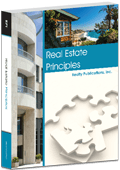The purchase agreement
For real estate sales conveying ownership of a property, the primary document used to negotiate the transaction between a buyer and seller is a purchase agreement form. [See RPI e-book Real Estate Principles Chapter 27]
While several variations of the purchase agreement exist which cater to the specialized use of some properties and the objectives of the transaction participants, the purchase agreement form used to negotiate the conventional financing of the purchase price on a one-to-four unit residential property is the Purchase Agreement (One-to-Four Residential Units – Conventional and Carryback Financing) form. [See RPI Form 150]
A buyer’s agent uses the Purchase Agreement (One-to-Four Residential Units – Conventional and Carryback Financing) published by Realty Publications, Inc. (RPI) to prepare and submit the buyer’s written offer to purchase a one-to-four unit residential property. [See RPI Form 150]
The pricing and terms for performance are limited to conventional financing, a takeover of existing mortgages, a carryback note or a combination of some of these arrangements.
This purchase agreement variation is also properly used by sellers when confronted with a counteroffer situation. Here, the seller’s agent prepares an entirely new purchase agreement, then submits it to the buyer’s agent as their fresh offer to sell on terms different from those contained in an unacceptable offer submitted by the buyer.
On acceptance, the purchase agreement becomes a binding written contract between the buyer and seller. To be enforceable, the price and terms for performance need to be clear, concise and complete to prevent misunderstandings.
To this end, a comprehensive purchase agreement includes as “boilerplate” all provisions that might be needed in any purchase transaction. They are designed to serve as a checklist of provisions an agent is to consider as a matter of best practices when preparing an offer. The various conventional financing arrangements and conditions a prudent buyer considers when making an offer to purchase a home are tightly worded for easy selection. [See RPI Form 150]
Related Video: Analyzing the Purchase Agreement
Click here for more information on this topic.
The Natural Hazard Disclosure Statement
Natural hazards are risks to life and property which exist in nature due to a property’s location. [See RPI e-book Real Estate Principles Chapter 17]
Whether a seller lists the property with a broker or markets the property themselves, the seller needs to disclose to prospective buyers any natural hazards known to the seller, including those contained in public records.
To unify and streamline the disclosure by a seller (and in turn the seller’s agent) for a uniform presentation to buyers concerning natural hazards which affect a property, the California legislature created a statutory form entitled the Natural Hazard Disclosure (NHD) Statement. [See RPI Form 314]
Compliance by the seller and seller’s agent to deliver the NHD Statement to the buyer is required to be documented by a provision in the purchase agreement. [See RPI Form 150 §11.5]
It is the buyer’s agent who has the duty to hand the buyer the NHD Statement the buyer’s agent receives from the seller or the seller’s agent, called delivery. [Calif. Civil Code §1103.12(a)]
Sellers and seller’s agents of any type of real estate are to disclose whether the property is located in:
- an area of potential flooding;
- a very high fire hazard severity zone;
- a state fire responsibility area;
- an earthquake fault zone; and
- a seismic hazard zone. [CC §1103.2]
A seller, seller’s agent and third-party natural hazard expert use the Natural Hazard Disclosure Statement published by RPI when a report on the natural hazards affecting a property is prepared for inclusion in a property marketing package, to disclose natural hazards of a property to prospective buyers for their review on commencement of negotiations as mandated.
Related Video: A Unified Natural Hazard Disclosure for All Sales
Click here for more information on this topic.
Very high fire hazard
Areas in the state which are subject to significant fire hazards have been identified as very high fire hazard severity zones. When a property is located in a very high fire hazard severity zone, a disclosure needs to be made to the prospective buyer. [See RPI Form 314 §3]
The city, county or district responsible for providing fire protection have designated, by ordinance, very high fire hazard severity zones within their jurisdiction. [Calif. Government Code §51179]
The fire hazard disclosure on the NHD form mentions the need to maintain the property. Neither the seller nor the seller’s agent need to explain the nature of maintenance required or its burden on ownership.
Advice to the buyer on the type of maintenance and the consequences of owning property subject to the maintenance are the duties of the buyer’s agent when they have an agent. [See RPI Form 314 §3]
Related Video: Disclosure of Fire Risks
Click here for more information on this topic.
State Fire Responsibility Area
When a property is in an area where the financial responsibility for preventing or suppressing fires is primarily on the state, the real estate is located within a State Fire Responsibility Area. [Calif. Public Resources Code §4125(a)]
When the property is located within a wildland area exposed to substantial forest fire risks, the seller or the seller’s agent is to disclose this fact. When the property is located in a wildland area, it requires maintenance by the owner to prevent fires. [Pub Res C §4136(a); See RPI Form 314 §4]
Additionally, the NHD Statement advises the prospective buyer of a home located in a wildland area that the state has no responsibility for providing fire protection services to the property, unless the Department of Forestry and Fire Protection has entered into a cooperative agreement with the local agency. No further disclosure about whether a cooperating agreement exists need be made by the seller or seller’s agent. [See RPI Form 314 §4]
However, when property disclosures place the property in a wildland area, the buyer’s agent has the duty to advise the buyer about the need to inquire and investigate into what agency provides fire protection to the property.
Related article:
Homeowners impacted by wildfires receive insurance protection
Want to learn more about this topic? Click the image below to download the RPI book cited in this article.

















